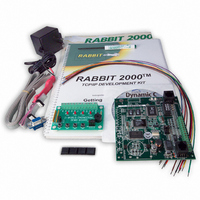101-0401 Rabbit Semiconductor, 101-0401 Datasheet - Page 33

101-0401
Manufacturer Part Number
101-0401
Description
KIT DEV RABBIT2000/TCP/IP
Manufacturer
Rabbit Semiconductor
Series
RabbitCore 2000r
Type
MPU Moduler
Datasheet
1.101-0402.pdf
(82 pages)
Specifications of 101-0401
Rohs Status
RoHS non-compliant
Contents
Rabbit 2000™ TCP/IP Development Board, Demo Board, Power Supply, Cable and Software
Processor To Be Evaluated
Rabbit 2000
Interface Type
RS-232, RS-485
For Use With/related Products
RCM2000, RCM2010, RCM2020
Lead Free Status / Rohs Status
Lead free / RoHS Compliant
Other names
101-0401
316-1005
Q906133
316-1005
Q906133
4.1 TCP/IP Connections
Before proceeding you will need to have the following items.
• If you don’t have Ethernet access, you will need at least a 10Base-T Ethernet card
• Two RJ-45 straight through Ethernet cables and a hub, or an RJ-45 crossover Ethernet
The Ethernet cables and Ethernet hub are available from Rabbit Semiconductor in a
TCP/IP tool kit. More information is available at www.rabbitsemiconductor.com.
1. Connect the AC adapter and the programming cable as shown in Section 2.2, “Connec-
2. Ethernet Connections
•
•
Getting Started
(available from your favorite computer supplier) installed in a PC.
cable.
tions.”
There are four options for connecting the TCP/IP Development Board to a network for
development and runtime purposes. These connections are shown in Figure 6. The first
two options permit total freedom of action in selecting network addresses and use of the
“network,” as no action can interfere with other users. We recommend one of these
options for initial development.
No LAN —
Development Board’s Ethernet port directly to the PC’s network interface card using an
RJ-45 crossover cable. A crossover cable is a special cable that flips some connections
between the two connectors and permits direct connection of two client systems. A
standard RJ-45 network cable will not work for this purpose.
Micro-LAN —
Ethernet 10Base-T hub and connect both the PC’s network interface card and the
TCP/IP Development Board’s Ethernet port to it using standard network cables.
Chapter 4 provides an introduction to using the TCP/IP features
on your TCP/IP Development Board.
The simplest alternative for desktop development. Connect the TCP/IP
4. U
Another simple alternative for desktop development. Use a small
SING THE
TCP/IP F
EATURES
29













